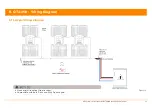
APsystems Microinverter QT2-208 Installation Manual 6
2. APsystems Microinverter System Introduction
This integrated system improves safety; maximizes solar energy harvest; increases system
reliability, and simplifies solar system design, installation, maintenance, and management.
Safety with APsystems Microinverters
In a typical string inverter installation, PV modules are connected in series. The voltage
adds-up to reach high voltage value (from 600Vdc up to 1000Vdc) at the end of the PV string.
This extreme high DC voltage brings a risk of electrical shocks or electrical arcs which could
cause fire.
When using an APsystems microinverter, PV modules are connected in parallel. Voltage at the
back of each PV module never exceeds PV modules Voc, which is lower than 60Vdc for most
of PV modules used with APsystems microinverters. This low voltage is considered “safe to
touch” by fire departments and negates the risk of electrical shock, electrical arcs and fire
hazards.
APsystems Microinverters maximize PV energy production
Each 2 input channels have individual Maximum Peak Power Tracking (MPPT) control, which
ensures that the maximum power is produced to the utility grid regardless of the
performance of the PV modules of other channels in the array. When PV modules in the array
are affected by shade, dust, different orientation, or any situation in which one channel
underperforms compared with the other channels, the APsystems Microinverter ensures top
performance from the array by maximizing the performance of each channel individually
within the array.
More reliable than centralized or string inverters
The distributed APsystems Microinverter system ensures that no single point of system failure
exists across the PV system. APsystems Microinverters are designed to operate at full power
at ambient outdoor temperatures of up to 65 deg C (or 149 F). The inverter case is designed
for outdoor installation and complies with the Type 6 environmental enclosure rating.
Simple to install
APsystems Microinvertes are compatible with most of 60 and 72 cell PV modules or 120 and
144 half-cut cells PV modules. (In order to confirm compatibility of PV module with
APsystems microinverter, feel free to check our online “E-decider” module compatibility tool
or contact your local APsystems Technical Support).
Installation requires a minimum number of accessories and microinverters offer a lot of
versatility to the installer: microinverters can indeed be installed on different roofs with
different orientation or with modules having different orientation.
In the same way, end-users can extend their system whenever they want with microinverters.
Smart system performance monitoring and analysis
The APsystems Energy Communication Unit (ECU) is installed by simply plugging it into any
wall outlet and providing an Ethernet or Wi-Fi connection to a broadband router or modem.
After installing and setting the ECU (see ECU Instruction Manual), the full network of
APsystems Microinverters automatically reports to the APsystems Energy Monitor and
Analysis (EMA) web server.








































